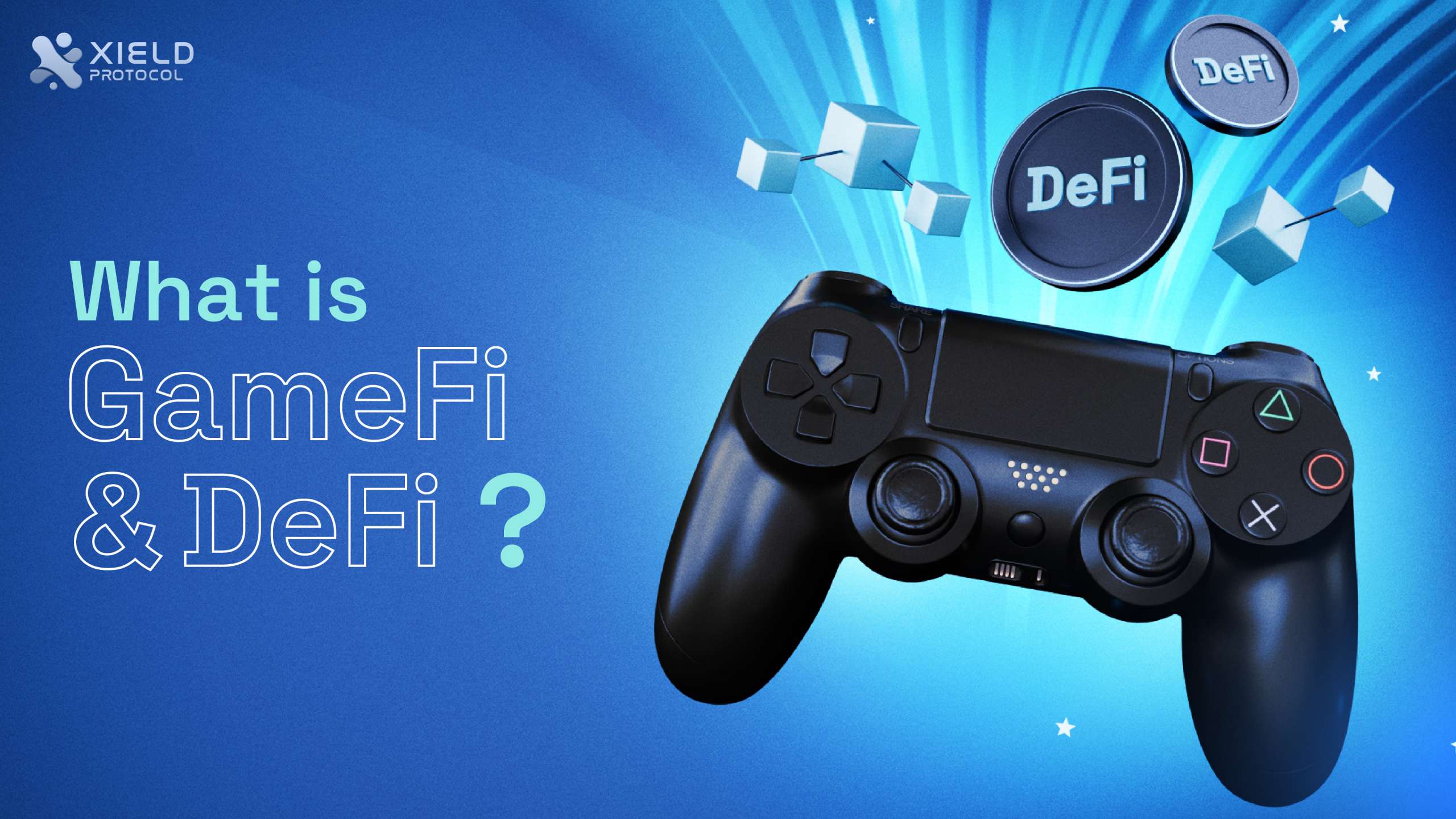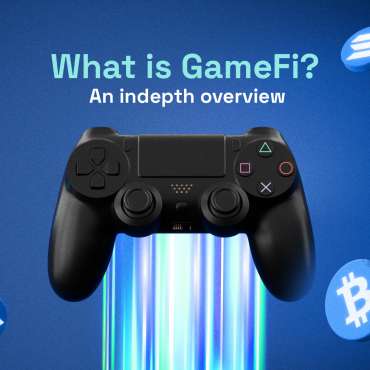GameFi and decentralized finance (DeFi) are two fascinating subsectors of Web3. GameFi is the intersection of gaming and money, whereas DeFi is a decentralized financial ecosystem. Both utilize blockchain technology and have the potential to transform traditional gaming and financial services.
According to Statista, around 3.3 billion people worldwide play video games. Many people play video games as a pastime, while others make a living off of it. GameFi lies at the crossroads of casual and professional gaming, allowing players to make money as they play. GameFi games employ blockchain technology and smart contracts to track and pay participants. The GameFi idea was introduced with “CryptoKitties,” an Ethereum-based GameFi project that allows users to acquire, breed, and trade cat NFTs. Since then, we have witnessed an explosion of play-to-earn games.
In this article, we’ll learn what GameFi and DeFi are, how they work, and what their future may hold.
What is GameFi?
The term “GameFi” refers to games that employ blockchain technology, non-fungible tokens (NFTs), and cryptocurrency. These games enable users to earn prizes in the form of tokens or NFTs. Players may then use their prizes to buy in-game items, exchange them with other players, or cash them out for real-world money (fiat).
The original GameFi projects were casual games that typically provided unsatisfactory gaming experiences, but the genre has evolved significantly in subsequent years. There are currently many different types of Web3 infrastructure games accessible, ranging from collectible card games to complicated role-playing games.
What is DeFi?
DeFi is a financial ecosystem based on blockchain technology that enables users to lend, borrow, trade, and earn interest without the need for a central authority. DeFi is still in its early phases, but it has the potential to completely transform the financial services sector.
The essential value of DeFi is that it is decentralized; no single person or entity has control. Instead, the platform is run by the users themselves.
This is accomplished by transparent and auditable software that enables trustless exchange between peers in a network. In a decentralized society, the goal is to share authority fairly. This contrasts starkly with traditional finance, where intermediaries such as banks and financial platforms are in control.
How are GameFi and DeFi merging?
GameFi and DeFi are merging in a variety of ways. Many games now leverage DeFi protocols and integrated DeFi activities, such as lending, to support their economies. This allows participants to earn rewards in the form of tokens or NFTs, which they may then use to engage in DeFi activities like lending, borrowing, or trading. For example, despite losing customers during the bear market, games like StepN and Walken have been adding DeFi functionality.
On the other side, DeFi projects are increasingly introducing gamification components into their platforms to attract users, make DeFi more accessible and interesting, and enhance user retention. For instance, certain DeFi projects enable users to earn rewards by playing games or completing quests.
Similarities between GameFi and DeFi
GameFi and DeFi have several similarities, particularly their usage of blockchain technology and decentralized principles. Let’s talk about those similarities:
Blockchain technology: It powers GameFi and DeFi’s platforms, allowing them to construct systems without the need for an intermediary. They build these solutions on the blockchain’s security, transparency, and immutability.
Decentralization: GameFi and DeFi aim to eliminate centralized systems from their respective sectors. GameFi wants to decentralize the gaming economy and assets, whereas DeFi seeks to decentralize financial services.
Ownership and control: Another similarity between GameFi and DeFi is that the owners own and control their assets. DeFi users have control of their digital assets, but GameFi players own their in-game assets, giving them authority over them.
Tokenization: Both GameFi and DeFi use tokenized assets. DeFi assets, such as cryptocurrencies and stablecoins, reflect ecosystem values, whereas GameFi tokenizer characters, weaponry, virtual real estate, and game skins as non-fungible tokens (NFTs).
Financial incentives: In decentralized finance, users can receive rewards for staking, yield farming, lending, and liquidity provision. This is similar to GameFi, where gamers may earn incentives for playing games, competing in tournaments, or selling in-game assets.
Interoperability: The capacity of a product or system to interact with other systems. Interoperability may be permitted between different GameFi platforms, allowing players to use their assets across many platforms. DeFi protocols can also be combined to build complicated goods and services.
GameFi growth
GameFi’s popularity continues to grow, with over 5 million active wallets participating in these play-to-earn games. Still, GameFi creators must overcome several challenges before this ecosystem can rival the size of the traditional gaming business. GameFi stores significant amounts of digital assets in crypto wallets, making them excellent candidates for hackers and vulnerabilities. Furthermore, transaction prices and speeds might distract from players’ game experiences.
Despite this HTF market intelligence, GameFi’s market value is projected to reach $46.8 billion by 2030. By April 2024, the number had grown to 3 million, representing a 300 percent growth in active users from 2023 to 2024. Popular businesses like Starbucks are developing GameFi games to reward users for engaging with their brands. In the future, we will probably see the GameFi ecosystem integrate with more brands and industries.
Trends in GameFi
As the GameFi ecosystem evolves, various trends and emerging possibilities are influencing its future path.
Metaverse Integration
The emergence of the metaverse, a shared virtual area in which users can interact, socialize, and engage in a variety of activities, provides a logical fit with GameFi. Platforms are looking for methods to link existing gaming experiences with metaverse environments, allowing gamers to smoothly switch between the virtual world and the play-to-earn economy.
Decentralized autonomous organizations (DAOs)
GameFi’s inherent decentralization characteristics make it an ideal platform for DAOs. These community-driven, self-governing institutions have the potential to shape GameFi’s future by giving players a direct say in the decision-making processes that control in-game economics and development roadmaps.
Interoperability and Cross-chain compatibility
As the GameFi ecosystem evolves, interoperability and cross-chain compatibility become increasingly important. Platforms that can smoothly integrate and support the trade of digital assets across various blockchain networks will gain a competitive edge by allowing players to freely relocate their holdings and participate in a more linked GameFi ecosystem.
Advances in Gaming Technology
The fast growth of gaming technology, including advances in visuals, immersive experiences, and cloud-based gaming, will add to the attraction and possibilities of GameFi platforms. As these technology advances are paired with DeFi concepts, the GameFi experience will become more engaging, visually appealing, and financially rewarding for players.
How Does GameFi Benefit the Gaming Industry?
Play-to-earn (P2E) model
Gameplay: Players participate in a variety of in-game activities such as fulfilling missions, battling, and moving up levels.
Rewards: Instead of only in-game awards, gamers receive cryptocurrency tokens, NFTs, or other blockchain-based assets. These awards are frequently sold, exchanged, or staked for a profit.
Blockchain infrastructure
Decentralization: Most GameFi games are based on blockchain networks (such as Ethereum, Binance Smart Chain, and Solana). This decentralization assures that assets are transparent, secure, and owned.
Smart Contracts: Smart contracts manage in-game regulations, reward distribution, and other critical functions—self-executing code that automates processes and eliminates the need for intermediaries.
NFT Integration
In-game Assets represented as NFTs: NFTs are used to represent in-game assets like weaponry, skins, characters, and virtual real estate. Secondary markets allow players to own, trade, and sell these assets.
Ownership and Scarcity: NFTs are unique, thus gamers own these digital things, and their scarcity can contribute to high market value.
Earning mechanisms
Staking: To acquire extra tokens or other benefits, players can stake their tokens in the game or on linked platforms.
Yield Farming: Players may earn income on their in-game assets or tokens by lending liquidity to decentralized exchanges.
Closing Thoughts
GameFi integrates the worlds of gaming with decentralized finance to give users greater control and ownership over in-game assets. The games’ decentralized design allows anybody to access them without the limitations and paywalls that are customary in traditional gaming. Once there, gamers may monetize their games in a variety of ways, including earning GameFi cryptocurrency tokens, trading NFTs, and even providing liquidity for game tokens on decentralized exchanges.
As the GameFi field grows, we may expect more fascinating titles. Traditional gaming businesses may take account and progressively give gamers ownership of certain in-game assets through the blockchain.




